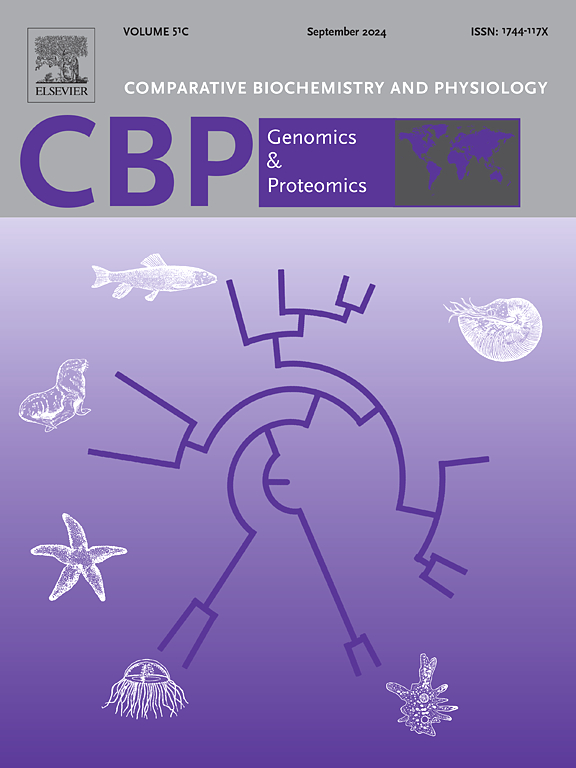Ocean acidity extremes retard shell formation of bivalve larvae: Insights from transcriptomics and lipidomics
IF 2.2
2区 生物学
Q4 BIOCHEMISTRY & MOLECULAR BIOLOGY
Comparative Biochemistry and Physiology D-Genomics & Proteomics
Pub Date : 2025-06-16
DOI:10.1016/j.cbd.2025.101566
引用次数: 0
Abstract
In view of climate change and human activities, ocean acidity extreme (OAX) events have been increasingly reported worldwide over the last decades, which possibly retard the growth and development of marine organisms, particularly at their early life-history stages (e.g., embryos or larvae). Thus, understanding whether they can adjust to the sudden increase in seawater acidity has drawn growing attention. Using a commercially and ecologically important bivalve species (Ruditapes philippinarum) with a widespread distribution in the world, we assessed the impact of OAX on its embryonic and larval development as well as expressions of functional genes and lipids to indicate physiological and cellular performance. We found that embryonic development and larval shell formation were inhibited by OAX mainly due to the downregulation of key genes responsible for the uptake of calcium ions from ambient seawater (e.g., NCX, VGCC and SERCA) and the reduced production of bicarbonate ions through the catalytic action of carbonic anhydrase. In addition, a major remodelling in membrane lipids (e.g., PC, PE, PG, PI and PS) indicated that OAX impacted the fluidity and stability of cell membrane, hindering the uptake of calcification substrates. The depletion in energy reserves, such as triacylglycerol, can also account for the impairment in larval shell formation under OAX conditions. By integrating transcriptomics and lipidomics, our findings illustrate a novel molecular mechanism underlying the detrimental effect of OAX on larval development and hence population maintenance of marine organisms, which can have profound implications for sustaining ecosystem stability and aquaculture management.

海洋酸度极端延缓双壳类幼虫的壳形成:来自转录组学和脂质组学的见解
由于气候变化和人类活动,近几十年来世界范围内越来越多地报道了海洋极端酸度事件,这些事件可能阻碍海洋生物的生长和发育,特别是在其生命早期阶段(如胚胎或幼虫)。因此,了解它们是否能够适应海水酸度的突然增加引起了越来越多的关注。利用一种广泛分布的具有重要商业价值和生态价值的双壳类(菲律宾Ruditapes philippinarum),我们评估了OAX对其胚胎和幼虫发育以及功能基因和脂质表达的影响,以指示生理和细胞性能。我们发现,OAX抑制了胚胎发育和幼虫壳的形成,主要是由于负责从环境海水中吸收钙离子的关键基因(如NCX、VGCC和SERCA)的下调,以及碳酸酐酶的催化作用减少了碳酸氢盐离子的产生。此外,膜脂(如PC、PE、PG、PI和PS)的主要重塑表明,OAX影响了细胞膜的流动性和稳定性,阻碍了钙化底物的吸收。能量储备的消耗,如三酰甘油,也可以解释OAX条件下幼虫壳形成的损害。通过整合转录组学和脂质组学,我们的研究结果揭示了OAX对海洋生物幼虫发育和种群维持不利影响的一种新的分子机制,这对维持生态系统稳定和水产养殖管理具有深远的意义。
本文章由计算机程序翻译,如有差异,请以英文原文为准。
求助全文
约1分钟内获得全文
求助全文
来源期刊
CiteScore
5.10
自引率
3.30%
发文量
69
审稿时长
33 days
期刊介绍:
Comparative Biochemistry & Physiology (CBP) publishes papers in comparative, environmental and evolutionary physiology.
Part D: Genomics and Proteomics (CBPD), focuses on “omics” approaches to physiology, including comparative and functional genomics, metagenomics, transcriptomics, proteomics, metabolomics, and lipidomics. Most studies employ “omics” and/or system biology to test specific hypotheses about molecular and biochemical mechanisms underlying physiological responses to the environment. We encourage papers that address fundamental questions in comparative physiology and biochemistry rather than studies with a focus that is purely technical, methodological or descriptive in nature.

 求助内容:
求助内容: 应助结果提醒方式:
应助结果提醒方式:


